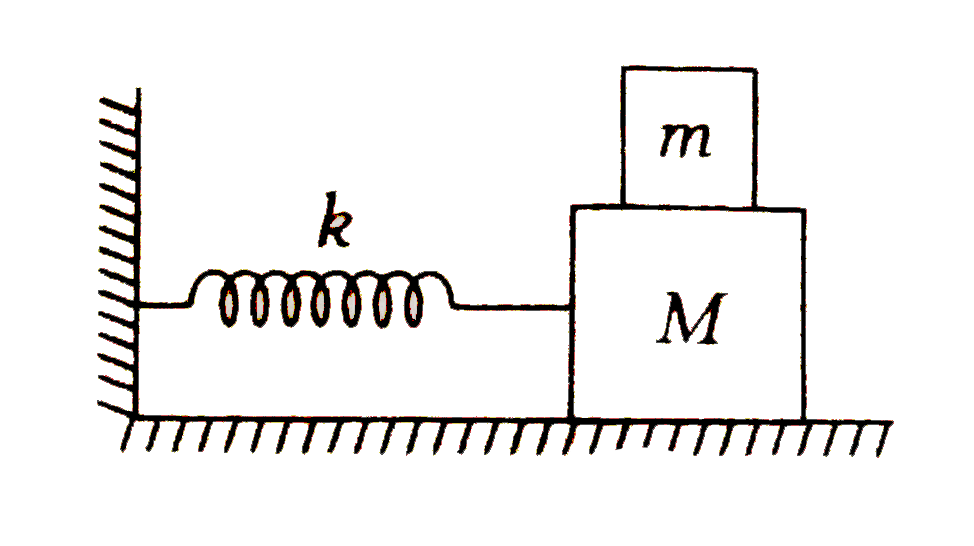In the figure shown the time period and the amplitude respectively, when m is left from rest when spring is relaxed are (the inclined plane is smooth)

2π√mk.mgsinθk
2π√msinθk.2msinθk
2π√mk.mgcosθk
None of the these
The correct Answer is:A
Mean position occurs when net force on block =0 ⇒mgsinθ=kx⇒x=mgsinθk
Amplitude = Distance between mean position and extreme position = x−0=mgsinθk
Topper's Solved these Questions
- SIMPLE HARMONIC MOTION BOOK - VMC MODULES ENGLISHCHAPTER - SIMPLE HARMONIC MOTION EXERCISE - LEVEL (2)
40 Videos
- SIMPLE HARMONIC MOTION BOOK - VMC MODULES ENGLISHCHAPTER - SIMPLE HARMONIC MOTION EXERCISE - 6-previous year question
56 Videos
- SIMPLE HARMONIC MOTION BOOK - VMC MODULES ENGLISHCHAPTER - SIMPLE HARMONIC MOTION EXERCISE - LEVEL 0 LONG ANSWER TYPE
2 Videos
- ROTATIONAL MOTION BOOK - VMC MODULES ENGLISHCHAPTER - ROTATIONAL MOTION EXERCISE - JEE Advanced (Archive) (True/False Type)
3 Videos
- SYSTEM OF A PARTICLES & ROTATIONAL MOTIONBOOK - VMC MODULES ENGLISHCHAPTER - SYSTEM OF A PARTICLES & ROTATIONAL MOTIONEXERCISE - IN-CHAPTER EXERCISE F
10 Videos
Similar Questions
Two blocks A and B are shown in figure have masses 5 kg and 4kg respectively. The system is released from rest. The speed of B after A has travelled the distance 1 m along the incline is (take g=10ms2 ,pulleys and strings are ideal and plane is smooth)
View SolutionA mass is suspended separately by two different springs in successive order then time period is t1 and t2 respectively. If it is connected by both spring as shown in figure then time period is t0, the correct relation is : -

View Solution
Knowledge Check
When body slides down from rest along smooth inclined plane making angle of 45∘ with the horizontal, it takes time T When the same body slides down from rest along a rough inclined plane making the same angle and through the same distance it is seen to take time pT, where p is some number greater that 1. Calculate late the coefficient of friction beween the body and the rough plane.
 .A1/PBμ=(1−1/p2)C1/p2D2-p
.A1/PBμ=(1−1/p2)C1/p2D2-p
A mass M is attached to a horizontal spring of force constant k fixed one side to a rigid support as shown in figure. The mass oscillates on a frictionless surface with time period T and amplitude A. When the mass M is in equilibrium position, another mass m is gently placed on it. When will be the new amplitude of ocillation?


View SolutionA block of mass m connected with a smooth prismatic wedge of mass M is released from rest when the spring is relaxed. Find the angular frequency of oscillation.

View SolutionA block of mass m is attached to a cart of mass 4m through spring of spring constant k as shown in the figure. Friction is absent everywhere. The time period of oscillations of the system, when spring is compressed and then released, is

View SolutionBlocks A and B shown in the figure are having equal masses m. The system is released from rest with the spring unstretched. The string between A and ground is cut, when there is maximum extension in the spring. The acceleration of centre of mass of the two blocks at this instant is

View SolutionWhen body slides down from rest along smooth inclined plane making angle of 45∘ with the horizontal, it takes time T When the same body slides down from rest along a rough inclined plane making the same angle and through the same distance it is seen to take time pT, where p is some number greater that 1. Calculate late the coefficient of friction beween the body and the rough plane.
 .
.
View SolutionThree blocks A, B and C of masses 5 kg, 5 kg and 10 kg respectively are connected with two light strings, one of them is passing over an ideal pulley The system is released from rest on smooth inclined plane of inclination 30" as shown in figure. The value of tension T1T2 is
View SolutionFind the time period of mass M when displaced from its equilibrium position and then released for the system shown in figure.

View Solution
